A Multi-Model Based Stability Analysis Employing Multi-Environmental Trials (METs) Data for Discerning Heat Tolerance in Chickpea (Cicer arietinum L.) Landraces
Abstract
:1. Introduction
2. Results
2.1. Variance Analysis for Yields
2.2. AMMI Biplot Analyses
2.2.1. Additive Main Effects and Multiplicative Interaction: AMMI 1
2.2.2. Additive Main Effects and Multiplicative Interaction: AMMI 2
2.3. WAASBY-Based Genotype Ranking for Stability and High Performance
2.4. Comparison of BLUP and AMMI Family Models
2.5. GEI Biplot Considering WAASB and ASV
2.6. GGE Biplot Based Analysis
2.6.1. “Which–Won–Where” Pattern
2.6.2. The Assessment of Stability across Environments Using the “Mean vs. Stability” Analysis of the GGE Biplot
2.6.3. Genotype Ranking
2.6.4. The GGE Biplot’s “Discriminativeness vs. Representativeness”
2.6.5. Test Environment Discrimination and Representation
3. Discussion
4. Materials and Methods
4.1. Plant Materials
4.2. Environments and Intercultural Practices
4.3. Data Collection and Statistical Analysis
5. Conclusions
Supplementary Materials
Author Contributions
Funding
Data Availability Statement
Acknowledgments
Conflicts of Interest
References
- Merga, B.; Haji, J. Economic Importance of Chickpea: Production, Value and World Trade. Cogent Food Agric. 2019, 5, 1615718. [Google Scholar] [CrossRef]
- Salaria, S.; Bindra, S.; Singh, I.; Rani, U.; Kumar, A.S.; Gill, B.S.; Singh, S. Introgression of Morphological, Phenological, and Productivity Traits Along with Disease Resistance from Cicer pinnatifidum into Cultivated Chickpea: A Success Story. Euphytica 2023, 219, 47. [Google Scholar] [CrossRef]
- Nabati, J.; Mirmiran, S.M.; Yousefi, A.; Zare Mehrjerdi, M.; Ahmadi-lahijani, M.J.; Nezami, A. Identification of diverse agronomic traits in chickpea (Cicer arietinum L.) germplasm lines to use in crop improvement. Legume Sci. 2023, 5, e167. [Google Scholar] [CrossRef]
- Krishnamurthy, L.; Gaur, P.M.; Basu, P.S.; Chaturvedi, S.K.; Tripathi, S.; Vadez, V.; Rathore, A.; Varshney, R.K.; Gowda, C.L.L. Large genetic variation for heat tolerance in the reference collection of chickpea (Cicer arietinum L.) germplasm. Plant Genet. Resour. 2011, 9, 59–69. [Google Scholar] [CrossRef]
- Mohammed, A.; Tana, T.; Singh, P.; Korecha, D.; Molla, A. Management options for rainfed chickpea (Cicer arietinum L.) in northeast Ethiopia under climate change condition. Clim. Risk Manag. 2017, 16, 222–233. [Google Scholar] [CrossRef]
- Devasirvatham, V.; Tan, D.K. Impact of High Temperature and Drought Stresses on Chickpea Production. J. Agron. 2018, 8, 145. [Google Scholar] [CrossRef]
- Pattison, A.L.; Uddin, M.N.; Trethowan, R.M. Use of in-situ field chambers to quantify the influence of heat stress in chickpea (Cicer arientinum). Field Crops Res. 2021, 270, 108215. [Google Scholar] [CrossRef]
- Osorio, E.; Davis, A.R.; Warkentin, T.D.; Bueckert, R.A. Ovule abortion and seed set of field pea (Pisum sativum L.) grown under high temperature. Can. J. Plant Sci. 2023, 103, 270–284. [Google Scholar] [CrossRef]
- Gaur, P.M.; Jukanti, A.K.; Varshney, R.K. Impact of Genomic Technologies on Chickpea Breeding Strategies. J. Agron. 2012, 2, 199–221. [Google Scholar] [CrossRef]
- Gaur, P.M.; Jukanti, A.K.; Samineni, S.; Chaturvedi, S.K.; Basu, P.S.; Babbar, A.; Jayalakshmi, V.; Nayyar, H.; Devasirvatham, V.; Mallikarjuna, N.; et al. Climate Change and Heat Stress Tolerance in Chickpea. In Climate Change and Plant Abiotic Stress Tolerance; Wiley-Blackwell: Hoboken, NJ, USA, 2013; pp. 837–856. [Google Scholar]
- Mohanty, J.; Thakro, V.; Parida, S.K.; Nair, H.; Dixit, G.P.; Jha, U.C. Delineation of Genes for a Major QTL Governing Heat Stress Tolerance in Chickpea; National Institute of Plant Genome Research (NIPGR): New Delhi, India, 2023. [Google Scholar]
- Singh, N.T.; Dhaliwal, G.S. Effect of Soil Temperature on Seedling Emergence in Different Crops. Plant Soil. 1972, 37, 441–444. [Google Scholar] [CrossRef]
- Kaushal, N.; Gupta, K.; Bhandhari, K.; Kumar, S.; Thakur, P.; Nayyar, H. Proline Induces Heat Tolerance in Chickpea (Cicer arietinum L.) Plants. Physiol. Mol. Biol. Plants. 2011, 17, 203–213. [Google Scholar] [CrossRef] [PubMed]
- Upadhyaya, H.D.; Dronavalli, N.; Gowda, C.L.L.; Singh, S. Identification and Evaluation of Chickpea Germplasm for Tolerance to Heat Stress. Crop Sci. 2011, 51, 2079–2094. [Google Scholar] [CrossRef]
- Devasirvatham, V.; Gaur, P.M.; Mallikarjuna, N.; Raju, T.N.; Trethowan, R.M.; Tan, D.K. Reproductive Biology of Chickpea Response to Heat Stress in the Field Is Associated with the Performance in Controlled Environments. Field Crop. Res. 2013, 142, 9–19. [Google Scholar] [CrossRef]
- Kumar, S.; Thakur, P.; Kaushal, N.; Malik, J.A.; Gaur, P.; Nayyar, H. Effect of Varying High Temperatures during Reproductive Growth on Reproductive Function, Oxidative Stress and Seed Yield in Chickpea Genotypes Differing in Heat Sensitivity. Arch. Agron. Soil Sci. 2013, 59, 823–843. [Google Scholar] [CrossRef]
- Chandel, S.S.; Sharma, K.D. Down-Regulation of Carbohydrate Metabolic Pathway Genes Lowers Sucrose and Starch Content in Chickpea Leaves Under High Temperature Stress. Natl. Acad. Sci. Lett. 2023, 46, 445–449. [Google Scholar] [CrossRef]
- Devasirvatham, V.; Gaur, P.M.; Raju, T.N.; Trethowan, R.M.; Tan, D.K.Y. Field response of chickpea (Cicer arietinum L.) to high temperature. Field Crops Res. 2015, 172, 59–71. [Google Scholar] [CrossRef]
- Rani, A.; Devi, P.; Jha, U.C.; Sharma, K.D.; Siddique, K.H.; Nayyar, H. Developing Climate-Resilient Chickpea Involving Physiological and Molecular Approaches with a Focus on Temperature and Drought Stresses. Front. Plant Sci. 2020, 10, 1759. [Google Scholar] [CrossRef]
- Jeffrey, C. Investigation into Physiology and Genetic Infrastructure Regarding the Impact of Heat Stress on Commercially Cultivated Chickpea. Doctoral Dissertation, The University of Sydney, Sydney, Australia, 2023. [Google Scholar]
- Singh, M.; Bhardwaj, C.; Singh, S.; Panatu, S.; Chaturvedi, S.K.; Rana, J.C.; Rizvi, A.H.; Kumar, N.; Sarker, A. Chickpea Genetic Resources and Its Utilization in India: Current Status and Future Prospects. Indian J. Genet. Plant Breed. 2016, 76, 515–529. [Google Scholar] [CrossRef]
- Bharadwaj, C.; Tripathi, S.; Soren, K.R.; Thudi, M.; Singh, R.K.; Sheoran, S.; Varshney, R.K. Introgression of “QTL-hotspot” region enhances drought tolerance and grain yield in three elite chickpea cultivars. Plant Genome 2021, 14, 1, e20076. [Google Scholar] [CrossRef]
- Danakumara, T.; Kumari, J.; Singh, A.K.; Sinha, S.K.; Pradhan, A.K.; Sharma, S.; Jha, S.K.; Bansal, R.; Kumar, S.; Jha, G.K.; et al. Genetic Dissection of Seedling Root System Architectural Traits in a Diverse Panel of Hexaploid Wheat through Multi-Locus Genome-Wide Association Mapping for Improving Drought Tolerance. Int. J. Mol. Sci. 2021, 22, 7188. [Google Scholar] [CrossRef]
- Coyne, C.J.; Kumar, S.; von Wettberg, E.J.; Marques, E.; Berger, J.D.; Redden, R.J.; Smýkal, P. Potential and limits of exploitation of crop wild relatives for pea, lentil, and chickpea improvement. Legume Sci. 2020, 2, e36. [Google Scholar] [CrossRef]
- Farshadfar, E. Incorporation of AMMI Stability Value and Grain Yield in a Single Non-Parametric Index (GSI) in Bread Wheat. Pak. J. Biol. Sci. 2008, 11, 1791. [Google Scholar] [CrossRef] [PubMed]
- Farshadfar, E.; Zali, H.; Mohammadi, R. Evaluation of Phenotypic Stability in Chickpea Genotypes Using GGE-Biplot. Ann. Biol. Res. 2011, 2, 282–292. [Google Scholar]
- Adjabeng-Danquah, J.; Manu-Aduening, J.; Gracen, V.E.; Asante, I.K.; Offei, S.K. AMMI Stability Analysis and Estimation of Genetic Parameters for Growth and Yield Components in Cassava in the Forest and Guinea Savannah Ecologies of Ghana. Int. J. Agron. 2017, 2017, 8075846. [Google Scholar] [CrossRef]
- Bocianowski, J.; Warzecha, T.; Nowosad, K.; Bathelt, R. Genotype by Environment Interaction Using AMMI Model and Estimation of Additive and Epistasis Gene Effects for 1000-Kernel Weight in Spring Barley (Hordeum vulgare L.). Appl. Genet. 2019, 60, 127–135. [Google Scholar] [CrossRef] [PubMed]
- Woldemeskel, T.A.; Fenta, B.A.; Mekonnen, G.A.; Endalamaw, H.Z.; Alemu, A.F. Multi-Environment Trials Data Analysis: An Efficient Biplot Analysis Approach; Springer: Berlin/Heidelberg, Germany, 2021. [Google Scholar]
- Singh, C.; Gupta, A.; Gupta, V.; Kumar, P.; Sendhil, R.; Tyagi, B.S.; Singh, G.; Chatrath, R.; Singh, G. Genotype × Environment Interaction Analysis of Multi-Environment Wheat Trials in India Using AMMI and GGE Biplot Models. Crop Breed. Appl. Biotechnol. 2019, 19, 309–318. [Google Scholar] [CrossRef]
- Philanim, W.S.; Kumar, A.; Shittegar, N.; Sankar, S.M.; Bharadwaj, C.; Ngangkham, U.; Bhattacharjee, B. Stability Analysis of Yield and Yield Related Traits in Ricebean (Vigna umbellata (Thunb.) Ohwi and Ohashi). Indian J. Genet. Plant Breed. 2022, 82, 208–216. [Google Scholar] [CrossRef]
- Srivastava, A.K.; Saxena, D.R.; Saabale, P.R.; Raghuvanshi, K.S.; Anandani, V.P.; Singh, R.K.; Dixit, G.P. Delineation of genotype-by-environment interactions for identification and validation of resistant genotypes in chickpea to fusarium wilt using GGE biplot. Crop Prot. 2021, 144, 105571. [Google Scholar] [CrossRef]
- Karkaj, F.A.; Hervan, E.M.; Roustaii, M.; Bıhamta, M.; Mohammadi, S. Comprehensive Stability Analysis of Wheat Genotypes through Multi-Environmental Trials. J. Agric. Sci. 2023, 29, 317–334. [Google Scholar]
- Olivoto, T.; Lucio, A.D.; da Silva, J.A.; Marchioro, V.S.; de Souza, V.Q.; Jost, E. Mean Performance and Stability in Multi-Environment Trials I: Combining Features of AMMI and BLUP Techniques. J. Agron. 2019, 111, 2949–2960. [Google Scholar] [CrossRef]
- Nataraj, V.; Bhartiya, A.; Singh, C.P.; Devi, H.N.; Deshmukh, M.P.; Verghese, P.; Gupta, S. WAASB-based stability analysis and simultaneous selection for grain yield and early maturity in soybean. Agron. J. 2021, 113, 3089–3099. [Google Scholar] [CrossRef]
- Li, Z.; Wu, W. Genotype recommendations for high performance and stability based on multiple traits selection across a multi-environment in rapeseed. Eur. J. Agron. 2023, 145, 126787. [Google Scholar] [CrossRef]
- Fischer, R.A.; Maurer, R. Drought Resistance in Spring Wheat Cultivars. I. Grain Yield Responses. Aust. J. Agric. Res. 1978, 29, 897–912. [Google Scholar] [CrossRef]
- Neisse, A.C.; Kirch, J.L.; Hongyu, K. AMMI and GGE Biplot for Genotype x Environment Interaction: A Medoid-Based Hierarchical Cluster Analysis Approach for High-Dimensional Data. Biom. J. 2018, 55, 97–121. [Google Scholar] [CrossRef]
- Harish, D.; Bharadwaj, C.; Kumar, T.; Patil, B.S.; Pal, M.; Hegde, V.S.; Sarker, A. Identification of Stable Drought-Tolerant Landraces of Chickpea (Cicer arietinum) Under Multiple Environments. Indian J. Agric. Sci. 2020, 90, 1575–1581. [Google Scholar]
- Matongera, N.; Ndhlela, T.; van Biljon, A.; Labuschagne, M. Genotype × Environment Interaction and Yield Stability of Normal and Biofortified Maize Inbred Lines in Stress and Non-Stress Environments. Cogent Food Agric. 2023, 9, 2163868. [Google Scholar] [CrossRef]
- Roostaei, M.; Jafarzadeh, J.; Roohi, E.; Nazary, H.; Rajabi, R.; Mohammadi, R.; Khalilzadeh, G.R.; Seif, F.; Mirfatah, S.M.M.; Amiri, S.S.; et al. Genotype × Environment Interaction and Stability Analyses of Grain Yield in Rainfed Winter Bread Wheat. Exp. Agric. 2022, 58, e37. [Google Scholar] [CrossRef]
- Smith, P.L. Sampling Errors of Variance Components in Small Sample Multifacet Generalizability Studies. J. Educ. Stat. 1978, 3, 319–346. [Google Scholar] [CrossRef]
- Gauch, H.G. Model Selection and Validation for Yield Trials with Interaction. Int. J. Biom. 1988, 44, 705–715. [Google Scholar] [CrossRef]
- Gauch, H.G.; Zobel, R.W. Predictive and Postdictive Success of Statistical Analyses of Yield Trials. Theor. Appl. Genet. 1988, 76, 1–10. [Google Scholar] [CrossRef]
- Gauch, H.G.; Zobel, R.W. Identifying Mega-Environments and Targeting Genotypes. Crop Sci. 1997, 37, 311–326. [Google Scholar] [CrossRef]
- Gauch, H.G. A Simple Protocol for AMMI Analysis of Yield Trials. Crop Sci. 2013, 53, 1860–1869. [Google Scholar] [CrossRef]
- Jorben, J.; Rao, A.; Bharadwaj, C.; Nitesh, S.D.; Tiwari, N.; Kumar, T.; Saxena, D.R.; Yasin, M.; Sontakke, P.L.; Jahagirdar, J.E.; et al. Multi-Trait Multi-Environment Analysis for Stability in MABC Lines of Chickpea (Cicer arietinum). Indian J. Agric. Sci. 2022, 92, 1005–1009. [Google Scholar] [CrossRef]
- Piepho, H.P. Best Linear Unbiased Prediction (BLUP) for Regional Yield Trials: A Comparison to Additive Main Effects and Multiplicative Interaction (AMMI) Analysis. Theor. Appl. Genet. 1994, 89, 647–654. [Google Scholar] [CrossRef] [PubMed]
- Gollob, H.F. A Statistical Model Which Combines Features of Factor Analytic and Analysis of Variance Techniques. Psychometrika 1968, 33, 73–115. [Google Scholar] [CrossRef] [PubMed]
- Yan, W.; Tinker, N.A. Biplot Analysis of Multi-Environment Trial Data: Principles and Applications. Can. J. Plant Sci. 2006, 86, 623–645. [Google Scholar] [CrossRef]
- Santchurn, D.; Badaloo, M.G.H.; Koonjah, S.; Dookun-Saumtally, A. Sugarcane breeding and supporting genetics research in Mauritius. Sugar Tech 2022, 24, 48–63. [Google Scholar] [CrossRef]
- Vaezi, B.; Pour-Aboughadareh, A.; Mohammadi, R.; Mehraban, A.; Hossein-Pour, T.; Koohkan, E.; Ghasemi, S.; Moradkhani, H.; Siddique, K.H.M. Integrating Different Stability Models to Investigate Genotype × Environment Interactions and Identify Stable and High-Yielding Barley Genotypes. Euphytica 2019, 215, 1–18. [Google Scholar] [CrossRef]
- Bharadwaj, C.; Satyavathi, C.T.; Subramanyam, D. Evaluation of Different Classifactory Analysis Methods in Some Rice (Oryza sativa) Collections. Indian J. Agric. Sci. 2001, 71, 123–125. [Google Scholar]
- Bharadwaj, C.; Patil, B.S.; Sankar, S.M.; Shimray, P.W.; Kumar, N.; Reddy, S.P.P.; Singhal, T.; Hegde, V.; Parida, S.K.; Roorkiwal, M.; et al. Evaluation and Identification of Stable Chickpea Lines for Yield-Contributing Traits from an Association Mapping Panel. J. Agron. 2022, 12, 3115. [Google Scholar]
- Spoorthi, V.; Ramesh, S.; Sunitha, N.C.; Vaijayanthi, P.V. Prediction of genotype performance for untested years based on additive main effects and multiplicative interaction and linear mixed models: An illustration using dolichos bean (Lablab purpureus (L.) Sweet) multiyear data. Ann. Appl. Biol. 2022, 180, 224–235. [Google Scholar] [CrossRef]
- Tara Satyavathi, C.; Bhat, K.V.; Bharadwaj, C.; Tiwari, S.P.; Chaudhury, V.K. AFLP Analysis of Genetic Diversity in Indian Soybean (Glycine max (L.) Merr.) Varieties. Genet. Resour. Crop Evol. 2006, 53, 1069–1079. [Google Scholar] [CrossRef]
- Yan, W.; Holland, J.B. A Heritability-Adjusted GGE Biplot for Test Environment Evaluation. Euphytica 2010, 171, 355–369. [Google Scholar] [CrossRef]
- Lin, C.S.; Binns, M.R. Concepts and Methods for Analyzing Regional Trial Data for Cultivar and Location Selection. Plant Breed. Rev. 2010, 12, 271–297. [Google Scholar]
- Bharadwaj, C.; Jorben, J.; Rao, A.; Roorkiwal, M.; Patil, B.S.; Ahammed, S.K.; Varshney, R.K. Development of high yielding Fusarium wilt resistant cultivar by pyramiding of “genes” through marker-assisted backcrossing in chickpea (Cicer arietinum L.). Front. Genet. 2022, 13, 1747. [Google Scholar] [CrossRef] [PubMed]
- Lin, C.S.; Binns, M.R. A Method of Analyzing Cultivar × Location × Year Experiments: A New Stability Parameter. Theor. Appl. Genet. 1988, 76, 425–430. [Google Scholar] [CrossRef]
- Cadersa, Y.; Santchurn, D.; Soulange, J.G.; Saumtally, S.; Parmessur, Y. Genotype-by-Environment Interaction for Marketable Tuber Yield in Advanced Potato Clones Using AMMI and GGE Methods. Afr. Crop Sci. J. 2022, 30, 331–346. [Google Scholar] [CrossRef]
- Tsenov, N.; Gubatov, T.; Yanchev, I. Effect of Genotype-Environment Interaction on Some Important Quality Parameters of Common Wheat (Triticum aestivum L.). J. Agric. Sci. Technol. 2023, 15, 1313–8820. [Google Scholar] [CrossRef]
- Carneiro, A.R.T.; Sanglard, D.A.; Azevedo, A.M.; Souza, T.L.P.O.D.; Pereira, H.S.; Melo, L.C. Fuzzy logic in automation for interpretation of adaptability and stability in plant breeding studies. Sci. Agric. 2019, 76, 123–129. [Google Scholar] [CrossRef]
- Khan, M.M.H.; Rafii, M.Y.; Ramlee, S.I.; Jusoh, M.; Al Mamun, M. AMMI and GGE Biplot Analysis for Yield Performance and Stability Assessment of Selected Bambara Groundnut (Vigna subterranea L. Verdc.) Genotypes Under the Multi-Environmental Trials (METs). Sci. Rep. 2021, 11, 22791. [Google Scholar] [CrossRef]
- Felipe, D.M.; Muhammad, Y. Agricolae: Statistical Procedures for Agricultural Research, R Package Version 1.4.0. 2022. Available online: https://github.com/myaseen208/agricolae (accessed on 20 August 2023).
- Olivoto, T.; Lucio, A.D.C. Metan: An R Package for Multi-Environmental Trial Analysis. Methods Ecol. Evol. 2020, 11, 783–789. [Google Scholar] [CrossRef]
- Piepho, H.P.; Möhring, J. Computing heritability and selection response from unbalanced plant breeding trials. Genetics 2007, 177, 1881–1888. [Google Scholar] [CrossRef] [PubMed]

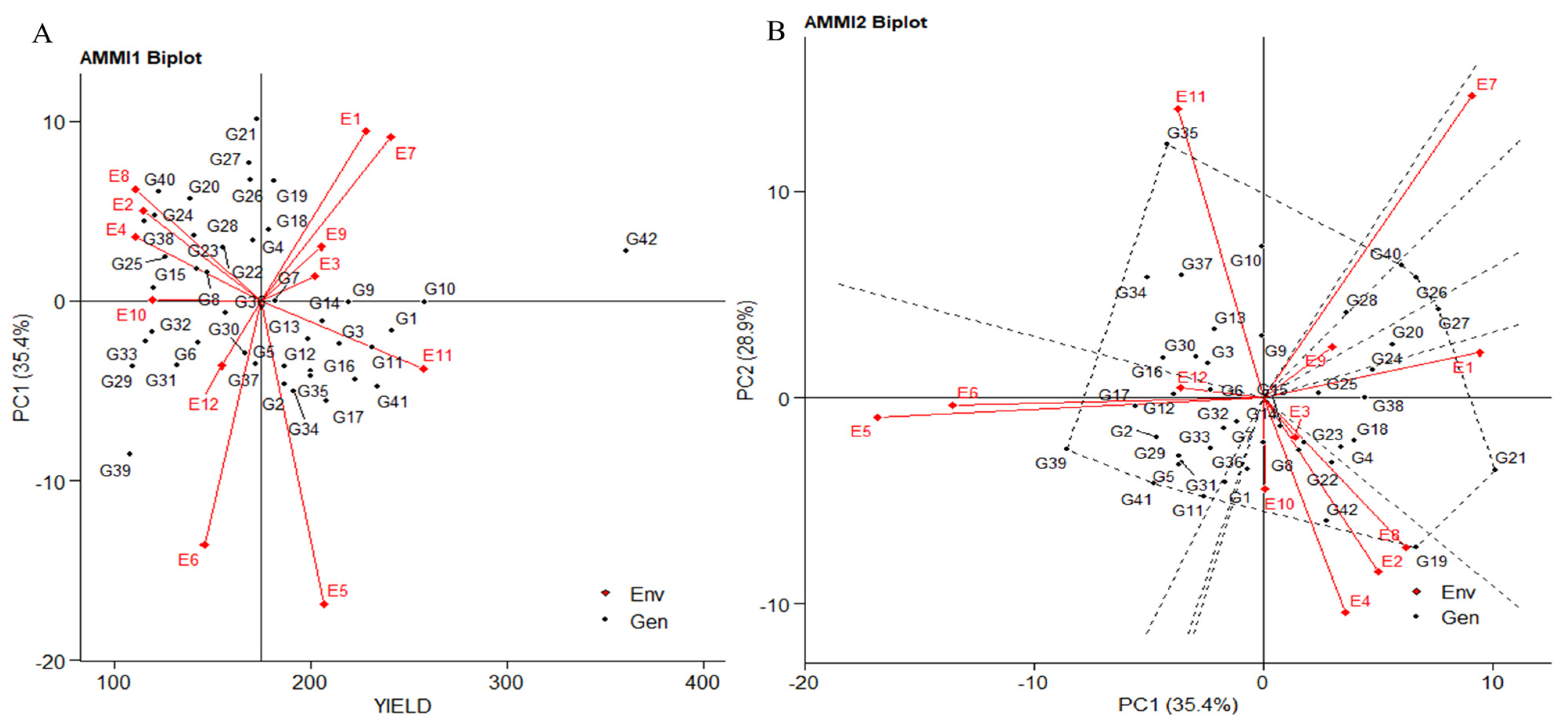
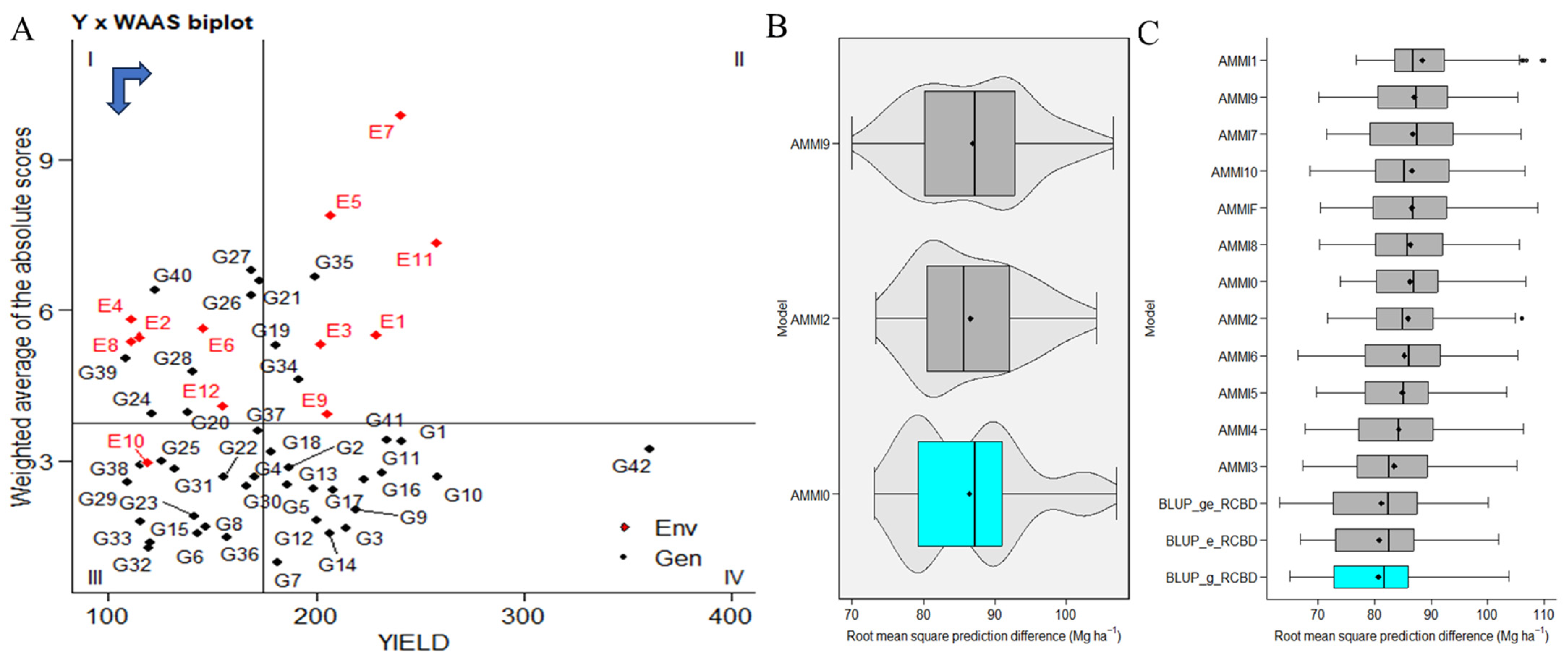
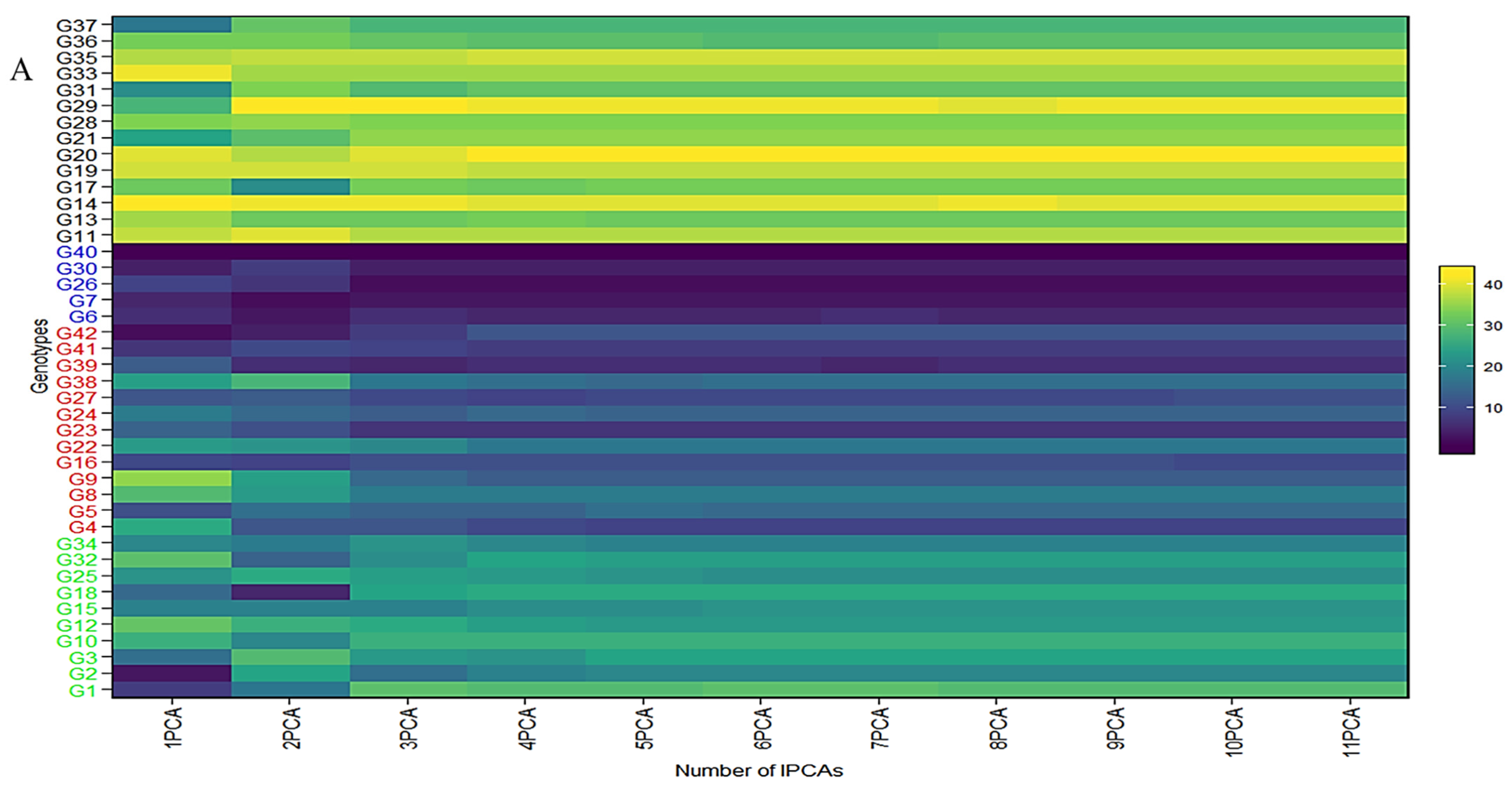
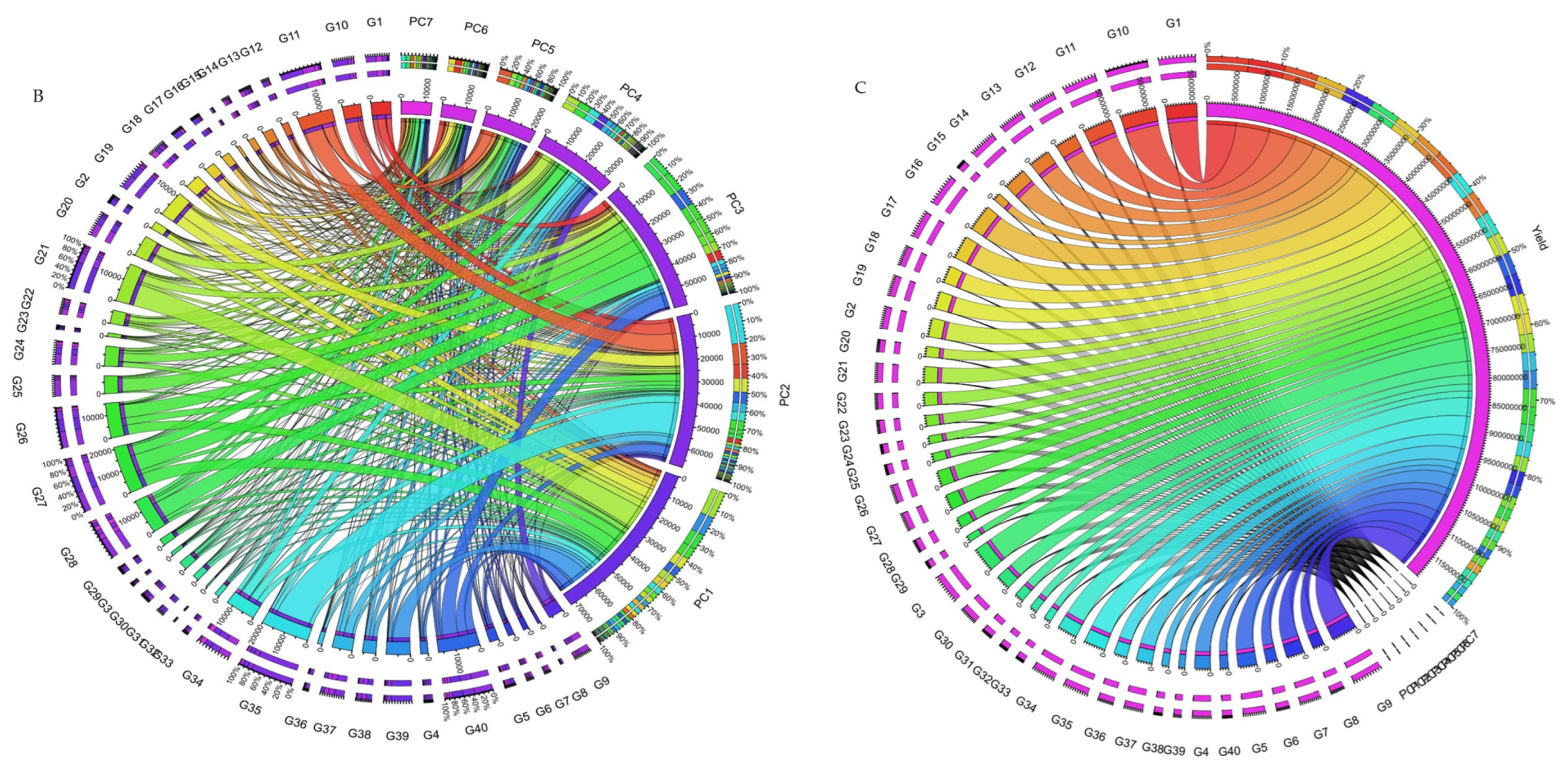
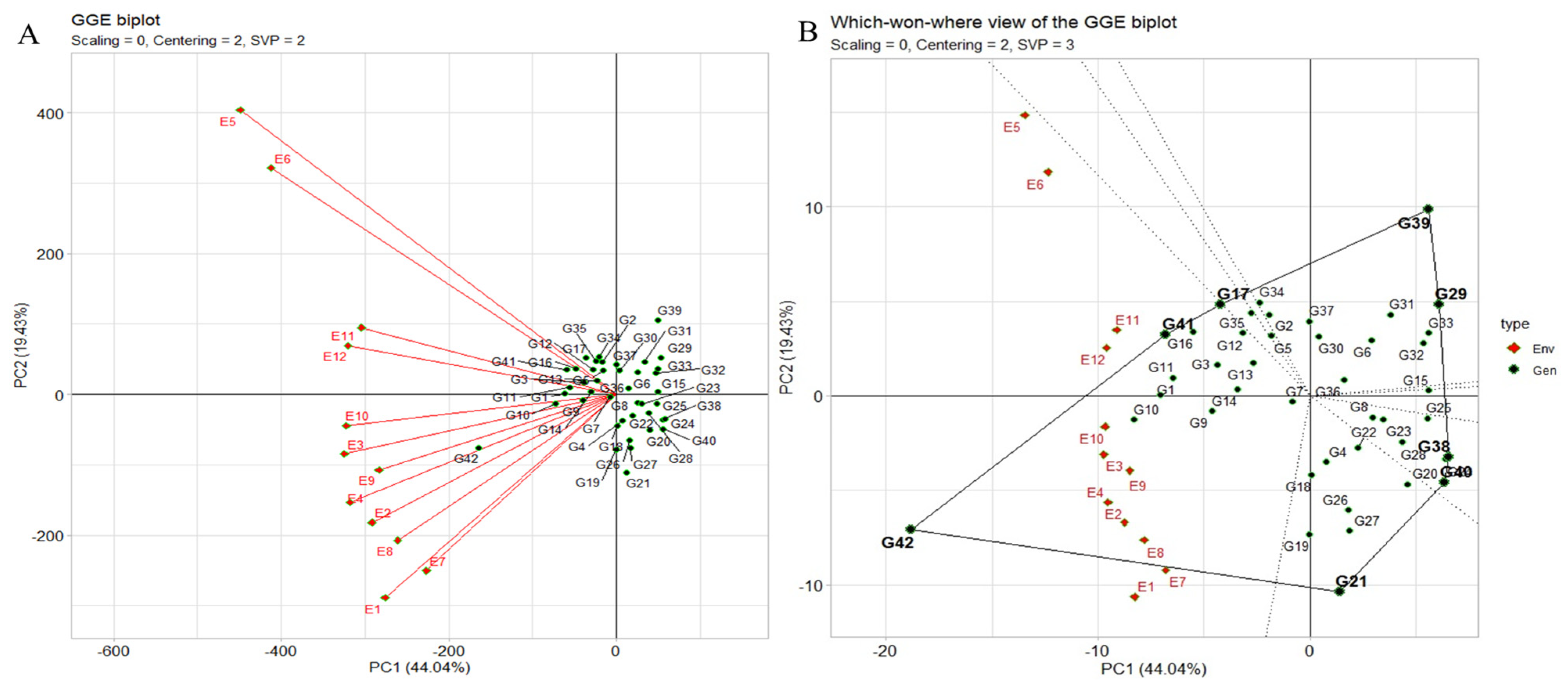
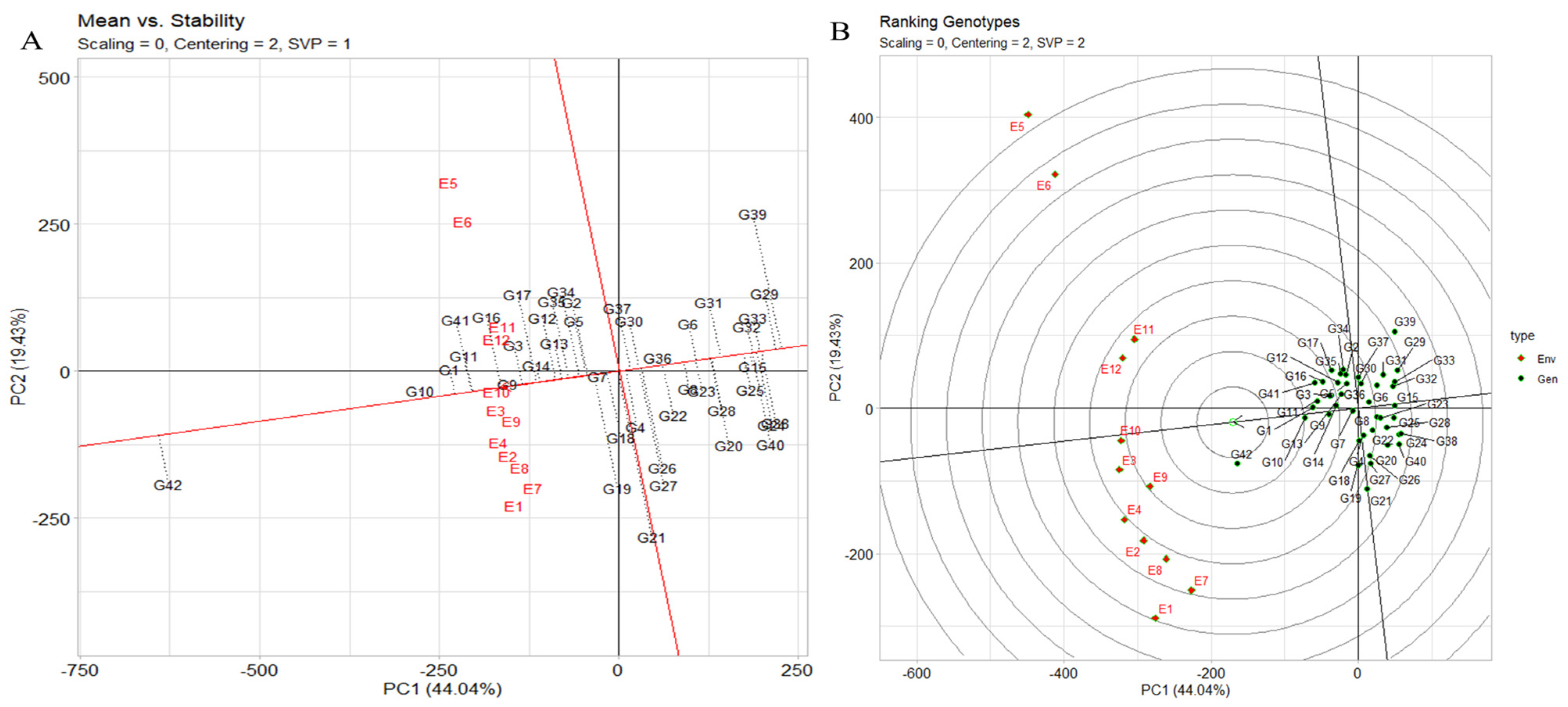
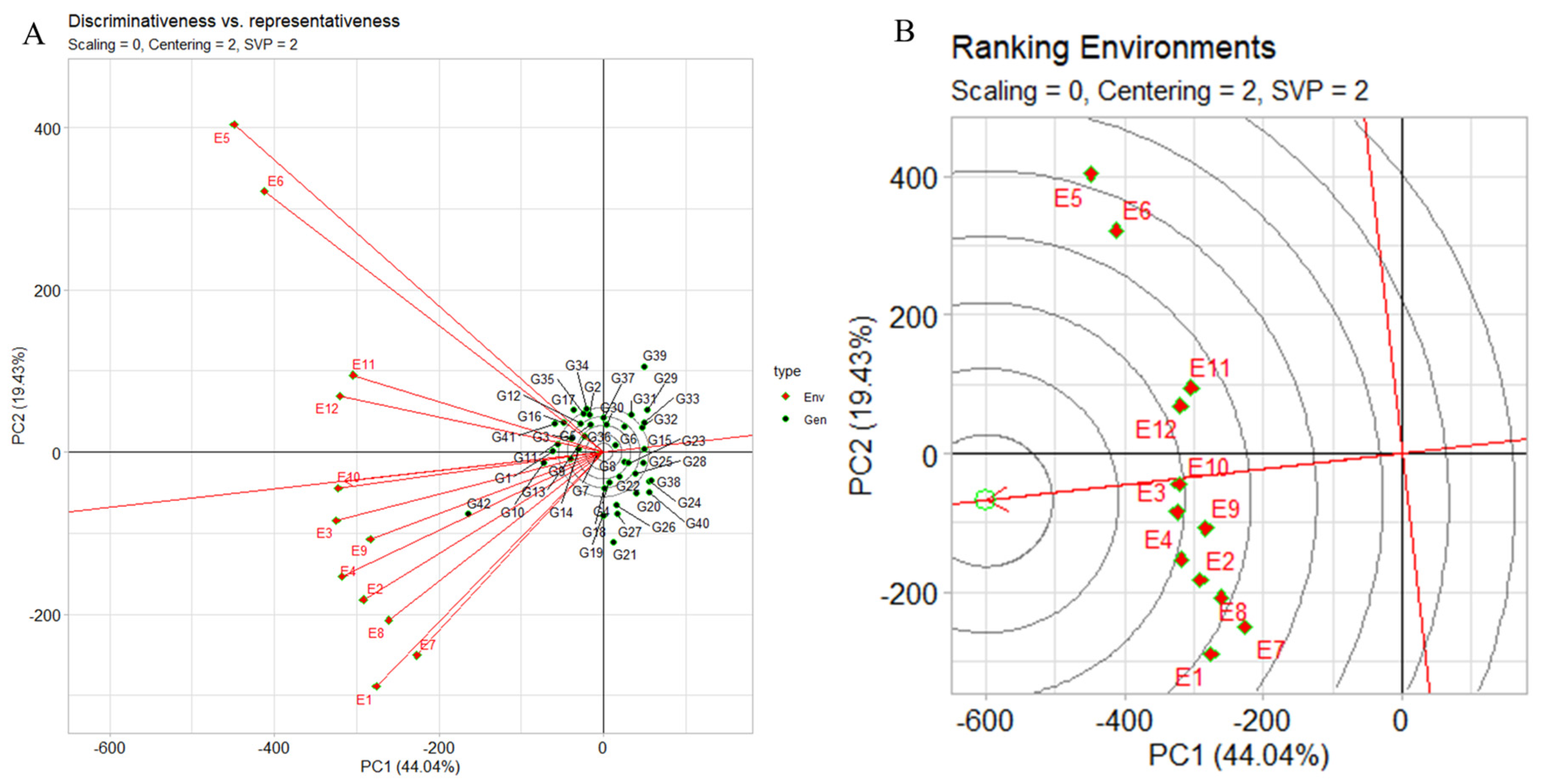
| Source of Variation | Df | Sum Sq | Mean Sq | F Value | Pr (>F) | Proportion | Accumulated |
|---|---|---|---|---|---|---|---|
| ENV | 11 | 4,159,096 | 378,099.6 *** | 9.99863 | 1.66 × 10−6 | ||
| REP(ENV) | 24 | 907,563.5 | 37,815.15 *** | 8.84942 | 1.25 × 10−28 | ||
| GEN | 41 | 3,644,107 | 88,880.67 *** | 20.79967 | 1.24 × 10−105 | ||
| GEN: ENV | 451 | 4,795,863 | 10,633.84 *** | 2.488509 | 1.5634 × 10−32 | ||
| PC1 | 51 | 1,699,822 | 33,329.84 *** | 7.8 | 0 | 35.4 | 35.4 |
| PC2 | 49 | 1,383,687 | 28,238.5 *** | 6.61 | 0 | 28.9 | 64.3 |
| PC3 | 47 | 1,041,098 | 22,151.02 *** | 5.18 | 0 | 21.7 | 86 |
| PC4 | 45 | 344,720.9 | 7660.464 *** | 1.79 | 0.0013 | 7.2 | 93.2 |
| PC5 | 43 | 158,258.7 | 3680.435 | 0.86 | 0.726 | 3.3 | 96.5 |
| PC6 | 41 | 62,198.48 | 1517.036 | 0.36 | 0.9999 | 1.3 | 97.8 |
| PC7 | 39 | 49,545.98 | 1270.41 | 0.3 | 1 | 1 | 98.8 |
| PC8 | 37 | 22,607.39 | 611.0104 | 0.14 | 1 | 0.5 | 99.3 |
| PC9 | 35 | 16,737.69 | 478.2197 | 0.11 | 1 | 0.3 | 99.6 |
| PC10 | 33 | 9285.812 | 281.3882 | 0.07 | 1 | 0.2 | 99.8 |
| PC11 | 31 | 7901.49 | 254.8868 | 0.06 | 1 | 0.2 | 100 |
| Residuals | 984 | 4,204,807 | 4273.178 | ||||
| Total | 1962 | 22,507,299 | 11,471.61 | ||||
| Overall Mean | 174.5151 | ||||||
| CV | 37.45783 |
Disclaimer/Publisher’s Note: The statements, opinions and data contained in all publications are solely those of the individual author(s) and contributor(s) and not of MDPI and/or the editor(s). MDPI and/or the editor(s) disclaim responsibility for any injury to people or property resulting from any ideas, methods, instructions or products referred to in the content. |
© 2023 by the authors. Licensee MDPI, Basel, Switzerland. This article is an open access article distributed under the terms and conditions of the Creative Commons Attribution (CC BY) license (https://creativecommons.org/licenses/by/4.0/).
Share and Cite
Danakumara, T.; Kumar, T.; Kumar, N.; Patil, B.S.; Bharadwaj, C.; Patel, U.; Joshi, N.; Bindra, S.; Tripathi, S.; Varshney, R.K.; et al. A Multi-Model Based Stability Analysis Employing Multi-Environmental Trials (METs) Data for Discerning Heat Tolerance in Chickpea (Cicer arietinum L.) Landraces. Plants 2023, 12, 3691. https://doi.org/10.3390/plants12213691
Danakumara T, Kumar T, Kumar N, Patil BS, Bharadwaj C, Patel U, Joshi N, Bindra S, Tripathi S, Varshney RK, et al. A Multi-Model Based Stability Analysis Employing Multi-Environmental Trials (METs) Data for Discerning Heat Tolerance in Chickpea (Cicer arietinum L.) Landraces. Plants. 2023; 12(21):3691. https://doi.org/10.3390/plants12213691
Chicago/Turabian StyleDanakumara, Thippeswamy, Tapan Kumar, Neeraj Kumar, Basavanagouda Siddanagouda Patil, Chellapilla Bharadwaj, Umashankar Patel, Nilesh Joshi, Shayla Bindra, Shailesh Tripathi, Rajeev Kumar Varshney, and et al. 2023. "A Multi-Model Based Stability Analysis Employing Multi-Environmental Trials (METs) Data for Discerning Heat Tolerance in Chickpea (Cicer arietinum L.) Landraces" Plants 12, no. 21: 3691. https://doi.org/10.3390/plants12213691
APA StyleDanakumara, T., Kumar, T., Kumar, N., Patil, B. S., Bharadwaj, C., Patel, U., Joshi, N., Bindra, S., Tripathi, S., Varshney, R. K., & Chaturvedi, S. K. (2023). A Multi-Model Based Stability Analysis Employing Multi-Environmental Trials (METs) Data for Discerning Heat Tolerance in Chickpea (Cicer arietinum L.) Landraces. Plants, 12(21), 3691. https://doi.org/10.3390/plants12213691







